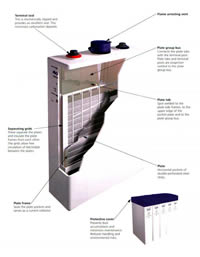Products - ALCAD Battery
Alcad have nearly 100 years, experience in the development and manufacture of pocket plate cells and batteries. Today, they offer the widest range of high quality nickel-cadmium batteries available throughout the world and these publication details the Single Cell ranges of pocket plate products. Alcad nickel-cadmium batteries are the battery of choice for many applications. Their outstanding features are:
The major design features of the Alcad Single Cell ranges are:
Alcad supports these Single Cell ranges with:
The Alcad Single Cell ranges meet, and exceed, the requirements of the IEC 60623 standard.
The Single Cell portfolio comprises three ranges of low, medium and high rate discharge types.
![]()
The L range has the thickest plates and is designed for applications where the battery is required to provide a reliable source of energy over relatively long discharge periods. Normally, the current is relatively low in comparison with the total stored energy and the discharges are generally infrequent. Typical uses are power back-up and bulk energy storage.

![]()
The M range is designed for applications where the batteries are usually required to sustain electrical loads for between 30 minutes to 3 hours or for « mixed » loads which involve a mixture of high and low discharge rates. The applications can have frequent or infrequent discharges. The range is typically used in power back-up applications.
![]()
The H range uses very thin plates and is designed for applications where there is a demand for a relatively high current over short periods, usually less than 30 minutes in duration. The applications can have frequent or infrequent discharges. The range is typically used in starting and power back-up applications.
Float-corrected data
Many nickel-cadmium batteries are used in stationary standby power applications where discharges occur infrequently and the battery is continuously charged by a float or constant potential charge. Under these circumstances there is a modification in the level of the discharge curve and allowances must be made for this when sizing the battery.
In order to simplify this process, the data Alcad supplies in this publication already takes into account this phenomenon. The data published by Alcad is the performance after prolonged floating and it can be used directly in battery sizing calculations.
This phenomenon occurs with all nickel-cadmium batteries, but some other manufacturers of nickel-cadmium batteries may not take this effect into account in published data.
When calculating for deep discharges (0.65 V and 0.85 V) it is not necessary to take this effect into account.
Standard layouts
Alcad has developed a series of standard layouts by which a battery may be ordered. Whether the battery is being installed on a rack, in a cabinet or is simply free-standing, the same configuration principals can be applied. There are two ways to configure the battery. The first is the normal method and is used on all LC..P, MC..P and HC..P cell types. The cell's length is used to calculate the row length, shown in figure 1 The second method is shown in figure 2 it is used on the majority of Alcad's LB..P, MB..P and HB..P cells, where the cell is turned through 90° and then connected width-to-width. This is referred to as 'crosswise' mounted and its purpose is to minimize the installation's overall length.




